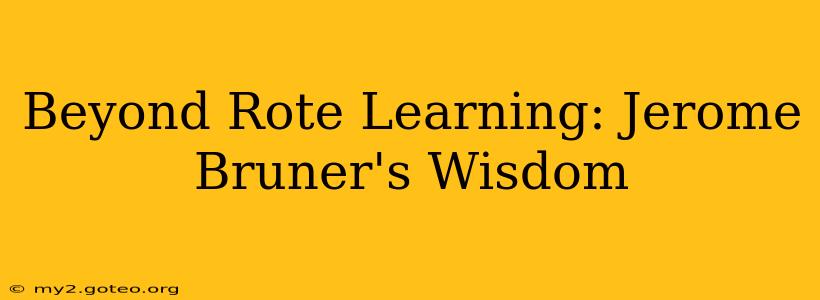Jerome Bruner, a towering figure in cognitive psychology, challenged the conventional approach to education with his revolutionary ideas on learning. His work transcended rote memorization, advocating for a deeper, more meaningful engagement with knowledge. This article delves into Bruner's key contributions, exploring how his principles can foster a more effective and enriching learning experience. We'll examine his core concepts and address common questions surrounding his influential theories.
What are Bruner's three modes of representation?
Bruner proposed three modes of representation that learners progress through as they develop: enactive, iconic, and symbolic. The enactive mode involves learning through direct manipulation and action. Think of a young child learning to ride a bike – they learn through doing, experiencing the physical sensations and adjustments required. The iconic mode uses images and mental pictures to represent knowledge. A child might draw a picture of a bike to represent their understanding of it. Finally, the symbolic mode uses abstract symbols, such as language and mathematical notations, to represent knowledge. This is the highest level of representation, allowing for complex and abstract thinking about the bike's mechanics, for example. Bruner emphasized the importance of progressing through these modes, with each building upon the previous one.
What is the spiral curriculum?
Bruner's concept of the spiral curriculum is a cornerstone of his approach. It suggests that complex subjects should be introduced early in a simplified form and then revisited repeatedly, building upon previous knowledge with increasing complexity and depth. This iterative approach allows learners to gradually grasp increasingly challenging concepts, ensuring a solid foundation before tackling more advanced material. Imagine learning about fractions: Initially, you might learn about halves and quarters. Later, you'll explore more complex fractions and their applications, building upon that initial understanding.
What is discovery learning according to Bruner?
Bruner championed discovery learning, emphasizing the importance of active learning where students construct their own knowledge through exploration and problem-solving. Rather than passively receiving information, learners are encouraged to actively seek out knowledge, formulate hypotheses, test them, and draw conclusions. This process fosters deeper understanding and retention than simply memorizing facts. A science experiment, where students design their own procedures and analyze results, is a prime example of discovery learning in action.
How does Bruner's theory apply to different learning styles?
Bruner's theory accommodates different learning styles by emphasizing the importance of multiple representations. Visual learners benefit from the iconic mode, while kinesthetic learners thrive in the enactive mode. The spiral curriculum's iterative nature caters to diverse learning paces, allowing students to revisit concepts at their own rhythm. This flexible approach makes Bruner's principles particularly valuable in inclusive classrooms.
What are the criticisms of Bruner's theory?
While highly influential, Bruner's theory isn't without its criticisms. Some argue that discovery learning can be inefficient, particularly for complex concepts requiring structured guidance. Others contend that the spiral curriculum might overload students if not implemented carefully. It's crucial to acknowledge these criticisms and adapt Bruner's principles thoughtfully, ensuring they align with the specific needs and context of the learners.
Conclusion: A Legacy of Meaningful Learning
Jerome Bruner's legacy extends far beyond rote learning. His emphasis on active engagement, meaningful understanding, and the iterative nature of learning continues to shape educational practices. By understanding and applying his principles, educators can foster a learning environment that empowers students to become active knowledge constructors, cultivating a deeper and more lasting understanding of the world around them. His insights remain relevant and crucial for creating truly effective learning experiences.

